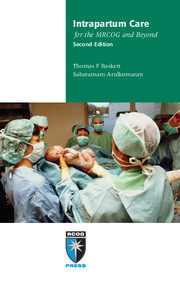Book contents
- Frontmatter
- Contents
- Preface
- Abbreviations
- 1 Improving intrapartum care
- 2 First stage of labour
- 3 Second stage of labour
- 4 Fetal surveillance in labour
- 5 Third stage of labour
- 6 Lower genital tract trauma
- 7 Induction of labour
- 8 Preterm labour and prelabour rupture of membranes
- 9 Assisted vaginal delivery
- 10 Shoulder dystocia
- 11 Breech vaginal delivery
- 12 Twin and triplet delivery
- 13 Caesarean section
- 14 Vaginal birth after caesarean section
- 15 Uterine rupture
- 16 Emergency obstetric hysterectomy
- 17 Cord prolapse
- 18 Antepartum haemorrhage
- 19 Postpartum haemorrhage
- 20 Acute uterine inversion
- 21 Amniotic fluid embolism
- 22 Disseminated intravascular coagulation
- 23 Acute tocolysis
- 24 Severe pre-eclampsia and eclampsia
- 25 Neonatal resuscitation
- 26 Perinatal loss: management of late fetal death and stillbirth
- Index
21 - Amniotic fluid embolism
Published online by Cambridge University Press: 05 July 2014
- Frontmatter
- Contents
- Preface
- Abbreviations
- 1 Improving intrapartum care
- 2 First stage of labour
- 3 Second stage of labour
- 4 Fetal surveillance in labour
- 5 Third stage of labour
- 6 Lower genital tract trauma
- 7 Induction of labour
- 8 Preterm labour and prelabour rupture of membranes
- 9 Assisted vaginal delivery
- 10 Shoulder dystocia
- 11 Breech vaginal delivery
- 12 Twin and triplet delivery
- 13 Caesarean section
- 14 Vaginal birth after caesarean section
- 15 Uterine rupture
- 16 Emergency obstetric hysterectomy
- 17 Cord prolapse
- 18 Antepartum haemorrhage
- 19 Postpartum haemorrhage
- 20 Acute uterine inversion
- 21 Amniotic fluid embolism
- 22 Disseminated intravascular coagulation
- 23 Acute tocolysis
- 24 Severe pre-eclampsia and eclampsia
- 25 Neonatal resuscitation
- 26 Perinatal loss: management of late fetal death and stillbirth
- Index
Summary
Although a rare event, occurring in 1/25000–80000 deliveries, amniotic fluid embolism (AFE) is perhaps the most catastrophic of all obstetric complications. In the developed world, AFE accounts for approximately 10% of all direct maternal deaths, rating it among the top three causes. The prominence of AFE is accounted for by the fact that, although it is a rare condition, the mortality rate is 30–80% and, even among survivors, the hypoxic insult is so profound that many have permanent neurological damage. There is some evidence that prompt resuscitation and intensive care lead to improved intact survival.
Pathophysiology
The pathophysiology of AFE is poorly understood. It has been suggested that many of the hallmarks of AFE are similar to those of septic shock and anaphylaxis. Furthermore, it has been established that amniotic fluid commonly enters the maternal circulation without ill effect in most women. It is postulated that in certain susceptible women, fetal cells and other vasoactive substances, such as prostaglandins and leukotrienes, may initiate, via endogenous mediators, a complex pathophysiological cascade similar to that seen in anaphylactic and septic shock. The sequelae are as follows:
• Initially, there is acute pulmonary arteriolar obstruction and hypertension. This is transient and soon followed by left ventricular failure resulting in profound hypotension.
• Next, there is severe hypoxia as a result of ventilation–perfusion imbalance. This, together with the hypotension, produces a generalised hypoxia, often leading to seizures. It is this profound and sustained hypoxia that is responsible for the neurological damage in survivors.
- Type
- Chapter
- Information
- Intrapartum Care for the MRCOG and Beyond , pp. 233 - 238Publisher: Cambridge University PressPrint publication year: 2011



